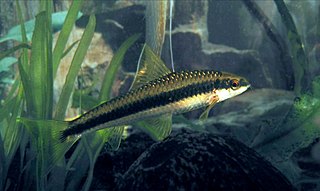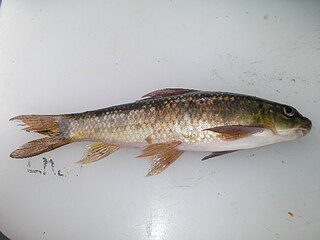
Lake Victoria is one of the African Great Lakes. With a surface area of approximately 59,947 km2 (23,146 sq mi), Lake Victoria is Africa's largest lake by area, the world's largest tropical lake, and the world's second-largest fresh water lake by surface area after Lake Superior in North America. In terms of volume, Lake Victoria is the world's ninth-largest continental lake, containing about 2,424 km3 (1.965×109 acre⋅ft) of water. Lake Victoria occupies a shallow depression in Africa. The lake has an average depth of 40 m (130 ft) and a maximum depth of 80–81 m (262–266 ft). Its catchment area covers 169,858 km2 (65,583 sq mi). The lake has a shoreline of 7,142 km (4,438 mi) when digitized at the 1:25,000 level, with islands constituting 3.7% of this length.

The rohu, rui, ruhi or roho labeo is a species of fish of the carp family, found in rivers in South Asia. It is a large omnivore and extensively used in aquaculture.

Catla, also known as the major South Asian carp, is an economically important South Asian freshwater fish in the carp family Cyprinidae. It is native to rivers and lakes in northern India, Bangladesh, Myanmar, Nepal, and Pakistan, but has also been introduced elsewhere in South Asia and is commonly farmed.

Lake Kossou is Côte d'Ivoire's largest lake. It lies on the Bandama River in the center of the country. It is an artificial lake, created in 1973 by damming the Bandama River at Kossou. Some 75,000 Baoulé people were displaced by the lake.

Barbels are a group of carp-like freshwater fish, almost all of the genus Barbus. They are usually found in gravel and rocky-bottomed moderate-flowing rivers with high dissolved oxygen content, known as the Barbel zone. A typical adult barbel can range from 25 to 240 cm in length and weigh between 200 g (7.1 oz) and 200 kg (440 lb), depending on species.

Labeo is a genus of carps in the family Cyprinidae. They are found in freshwater habitats in the tropics and subtropics of Africa and Asia.
The ningu is a species of ray-finned fish in the family Cyprinidae. It is found in the Lake Victoria basin in Burundi, Kenya, Tanzania, and Uganda. Its natural habitats are rivers, swamps, freshwater lakes, freshwater marshes, and inland deltas. It is threatened by a loss of habitat due to pollution, siltation and drainage as agriculture expands in the Lake Victoria basin, by overfishing on their breeding migrations and by introduced alien fish.

There are two major sources of fish in Uganda; one is from aquaculture, the other from fishing in rivers and lakes. The latter has made up the largest and most significant share of all fishing. Open water covers 15.3 percent of Uganda's surface and comprises five major lakes which are the main sources of fish in the country. Lake Victoria continues to be the most important water body in Uganda both in size and contribution to the total fish catch, followed by Lake Albert and Lake Kyoga.

The fishing industry in the land-locked country of Laos is a major source of sustenance and food security to its people dwelling near rivers, reservoirs and ponds. Apart from wild capture fisheries, which is a major component of fish production, aquaculture and stocking are significant developments in the country. Historically, fishing activity was recorded in writings on the gate and walls of the Wat Xieng Thong in Luang Prabang dated 1560. For many Laotians, freshwater fish are the principal source of protein. The percentage of people involved in regular fishing activity is very small, only near major rivers or reservoirs, as for most of the fishers it is a part-time activity.

Labeoninae is a doubtfully distinct subfamily of ray-finned fishes in the family Cyprinidae of order Cypriniformes. They inhabit fresh water and the largest species richness is in the region around southern China, but there are also species elsewhere in Asia, and some members of Garra and Labeo are from Africa. They are a generally very apomorphic group, perhaps the most "advanced" of the Cyprinidae. A common name for these fishes is labeonins or labeoins.

The orangefin labeo is a fish of the carp family Cyprinidae, found commonly in rivers and freshwater lakes in and around South Asia and South-East Asia. Native to Bangladesh and India.

Labeo angra is a species of fish in the family Cyprinidae, the carps and minnows. It is commonly known as the Angra labeo. It is native to Asia, where it is distributed in Bangladesh, Burma, Nepal, and Pakistan. It has also been reported from Afghanistan.
The rednose labeo is a species of fish in the family Cyprinidae, the carps and minnows. Other common names include Hunyani labeo, Manyame labeo, rednose mudsucker, and sailfin mudsucker. It is native to Africa, where it is distributed in the Democratic Republic of the Congo, Malawi, Mozambique, Zambia, and Zimbabwe.

Labeo coubie, the African carp, is a cyprinid fish, widespread in Africa, where it occurs within the drainage basin of the Nile and in the Chad, Niger-Benue, Volta, Senegal and Gambia Rivers, as well as the Cross River and Cameroon coastal rivers. Furthermore, it is also known from East Africa and the middle reaches of the Congo. Records from the Zambezi drainage need confirmation.
Labeo meroensis is fish in genus Labeo from the Nile River in Sudan.

The Nile carp is a fish species in the genus Labeo. It feeds primarily on plankton, and is distributed along the entire Nile valley. It is generally believed to be the fish that swallowed the phallus of the Egyptian god Osiris in the myth regarding his death at the hands of his brother Seth.

The redeye labeo or African carp is a species of fish in the cyprinid genus Labeo. It is a freshwater fish endemic to the rivers of East Africa, from the Zambezi through the Limpopo and Komati Rivers to the Pongola River. It also inhabits upper and middle parts of the Congo River.
L. niloticus may refer to:

Aquaculture Research and Development Centre, Kajjansi (ARDC), is a national centre responsible for aquaculture research and development in Uganda. It is a branch of the National Fisheries Resources Institute (NAFIRRI).
Labeo latebra is a species of freshwater fish belonging to the genus Labeo. It is endemic to the upper Nile basin in Sudan.














